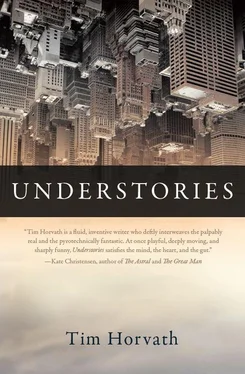I want to share it with someone, but the street is silent. Others, out there beyond my block, must be watching this, too, but I can’t think of anyone. For a moment I consider calling one of my former students — there are over a thousand, with one or two who stand apart, who might pick up warmly, wish to talk about things other than the eclipse, inquire how I am and ask after Saskia. I might take poetic license, borrowing the stories of some of my more illustrious colleagues about consulting with the designers of the game Goad, (“gonna make Halo look like Ms. Pac-Man”), about extra-tight security clearance while decoding maps, sifting for the anomalies whose discovery could forestall disaster. Something about this incarnation of the moon makes the truth feel malleable, as if it can be suspended without altering its fundamental features.
But then, I think, why not just be blunt — the department’s on the brink of oblivion, and a tinge of black mold sits on my shoes from earlier in the week. I glance at it; in this earth-fed moonlight, it is nearly impossible to resist finding a pattern there, something that belongs and will persist long after I slip them off and head upstairs.
Urban Planning: Case Study Number Four
It is hard to convey to you, who have never been to Ganzoneer, the comic futility that attends any attempt to walk there, due to the elasticity of her streets, walls, and sidewalks, which send the newcomer flailing and sprawling. If you are seeking to anchor yourself after a stretch of limbo, of water treading, of one of those aimless periods that life occasionally thrusts upon us all, go onward. You’ll find nothing solid here, with the exception of the Old Quarter, where scattered vestiges of the former Ganzoneer remain, like the stalwart North Church, jutting upward as if slicing at the sky. Once, she was like any other city, hard concrete, all corners and edges, and residents will still go to that part of town every so often to rub their hands almost religiously against the gritty surfaces.
The rest of the city undulates underfoot in a sort of gelatinous mass — it jiggles. Most cities are ectomorphic; Ganzoneer is the consummate endomorph. Residents of nearby Vitmora go so far as to call her “the Splayed Fleshpot,” maligning her central thoroughfare, Innapovna Street, as “Thong Blvd.,” and adding further insult by pronouncing this “ bllllllllvvvddd .” This can be chalked up mainly to pettiness, since Vitmorans would rather slam their neighbors than face up to their own problems, which have driven the city’s last three mayors to drug addiction, shameless promiscuity, and a gunshot wound to the medial-temporal lobe, respectively. Sure, Ganzoneer isn’t what most would consider graceful. Once one acclimates to her peculiar genus of motion, though, she harbors no shortage of loveliness; it wouldn’t occur to her long-term residents to demean her with “jiggles,” nor compare her to a beached cetacean. No, you are far more likely to hear them remarking on her sublime way of yielding to the slightest air current, the sensuousness of her rippling, the jaunt and jounce she lends to the most ordinary stroll.
The brochure Your New Home: Ganzoneer opens:
Planning to relocate here? Great! However, please heed some advice from those who have preceded you here (and there are many). Your first days and nights (but especially days) in Ganzoneer can be disconcerting, reminiscent of the transition a box spring — mattress sleeper undergoes when s/he fulfills the lifelong dream of owning a water bed. It is highly recommended that those planning to move here, in fact, sleep in a water bed and spend a couple of hours a day on some form of trampoline or rent an inflatable “moonwalk” contraption for up to a month beforehand. Though this will not fully prepare you for your first day on the street, it will significantly reduce some of the initial shock. We do not recommend the “acclimation shoes” that some are selling (that go by “ganzies” on the black market), as these are based on altogether different principles and will actually make it harder once you get here, though if you are not relocating here, we’d opine they can be quite fashionable.
Remember that YOU are mostly water yourself, and thus that the polymer-based proprietary hydropolylipidinous compounds that comprise most of the city’s architecture are hardly alien to your own anatomical makeup. In fact, you are more like Ganzoneer by far than you are like Paris, Delagotha, New York, or Raedmeon (unless you are a cement-, metal-, and glass-based sentient creature. In which case, Welcome, Cement-, Metal-, and Glass-Based Sentient Creature!). Become, then, more like what you are — where other cities, even those tropical ones beneath lolling fronds, offer up hard corners, horizontals and verticals at every turn, the resistance of straight edges, Ganzoneer offers you naught but embraces, caresses, bouncy, jubilant, TRULY TROPICAL moments.
Ganzoneer: Become More Like What You Are.
Emila cringes when she thinks of that catchphrase, when it catches her; the whole brochure hounds her line by line, in fact, though she reminds herself that she wrote it under tight deadline, under “snark attack,” as she calls it, from Maypeath, her boss. That this voice — so distant from her own sensibility, so crass and patently patronizing, so transparently manipulative — that this voice nevertheless came from somewhere within her makes her shudder. Initially, she thought she could be the closet intellectual who just happened to pay the bills at the Bureau of Tourism — after all, they’d hired her on the basis of her credentials, right? She was overqualified, sure, and they all knew it, but she made extra sure her copy was unassailably down-to-earth, vernacular, employee-of-the-month-friendly.
And still, she’d hoped to smuggle in her thesis (sweet subversion), which argued for a secret link between phenomenology and sociology, positing that the majority of crime, poverty, homelessness, and mental illness could be traced not to the heightened density of population, nor to anonymity, nor to materialism (these she argued against). No, the root cause was simple hardness, the unforgiving nature of pavement, from which blood, vomit, death, and grief are too easily wiped clean. It was that simple: Cities, like prisons, secreted their essence into your flesh, turning you hard as they were, perhaps not overnight but assuredly over time. She’d tried to spell it out in the brochure: “The steely resistance and determined glares that worked in other cities will not only disappoint here but will undermine your very intentions.” Maypeath red-lined it, reverting instinctually to his mantra: “Focus on the positive.” Thus Ganzoneer wound up a partly chewed gum wad, a sex-starved temptress — that, she thinks, is how in the end her brochure packages her city.
She remembers her own arrival in Ganzoneer: no water bed, no bounce machine, no special shoes, just a lonely twenty-four-year-old with dry light-brown hair, a degree in sociology from Vitmora’s most prestigious university, and an attraction to the library that verged on the agoraphobic. Having gazed longingly over Ganzoneer from her cell-like turret for years, she finally had the opportunity to go there and test out her theory. Her first day was hellish, an experience she could only compare to seasickness, each step like being on a tiny deck in tumultuous open seas. She’d had no idea where to focus her gaze, the whole city swaying pendulously, and her along with it. Others seemed to negotiate the streets so easily, to glide with the swarthy ease of skaters adept enough to chase pucks, one another. When she fell the first of numerous times, instead of skinning a palm or knee, Emila felt herself caught in a series of tiny falls, an errant ball arriving slowly at inertia.
Читать дальше












